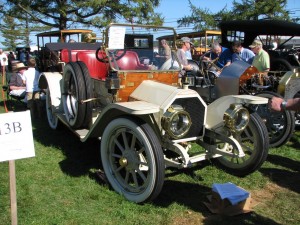 Stearns and Stearns-Knight automobiles were marketed by F. B. Stearns and Company (later F.B. Stearns Company). Stearns was an American manufacturer of luxury cars in Cleveland, Ohio.
Stearns and Stearns-Knight automobiles were marketed by F. B. Stearns and Company (later F.B. Stearns Company). Stearns was an American manufacturer of luxury cars in Cleveland, Ohio.
Frank Ballou Stearns (1879–1955) was an early automotive pioneer who, in 1896, built his first experimental car at the age of seventeen, in the basement of the family home. He built a four-cylinder car as early as 1897. His father allowed him to proceed and supported him with money and a barn they converted into a machine shop.
The first production model evolved in 1898; it was a gasoline-fuel buggy-style automobile with a one-cylinder engine, horizontal under the floor, tiller steering, wire wheels, planetary transmission, and chain drive. In the same year, F. B. Stearns & Company was organized with his partners, brothers Raymond M. and Ralph L.
 As early as 1901, he introduced a steering wheel instead of the tiller, and advanced to a gasoline runabout with a one-cylinder engine under the seat, and single chain drive. Until then, about 50 cars had been built.
As early as 1901, he introduced a steering wheel instead of the tiller, and advanced to a gasoline runabout with a one-cylinder engine under the seat, and single chain drive. Until then, about 50 cars had been built.
For 1902, Stearns offered a variety of models, including a touring car model equipped with a front-mounted, 24 H.P. water-cooled flat twin motor and speed transmission. Notably, all vehicle controls were situated on the steering wheel. The armored wood-framed car weighed 2800 lbs., seated six passengers, and sold for $3,000.
In 1904, Stearns had a very European four-cylinder 36 H.P. with pressed steel chassis, wheelbase of 111 inches and four-speed gearbox but a distinctly American (i.e., backward) coil and battery, rather than the magneto typical in Europe. This changed in 1905, when the 32/40 made magneto became standard, and the wheelbase grew to 118 inches. Stearns used the slogan Runs like A Deer in this year.
1905 brought a new design change that was again bigger and which provided the only offering from the small Cleveland manufacturer. It was a huge automobile with a four-cylinder L-head engine with a block cast in pairs and mechanically operated side valves delivering 40 H.P with a wheelbase of 118 inches. It was called the model 32/40 and was available as a very expensive 7-passenger Touring that set a buyer back a hefty $4,150.
Stearns introduced a 40/45 four in 1906, with aluminum body panels, tonneau, and windshield, with “no less than 17 coats of paint”, at a cost of $5,200. This car shared the wheelbase of previous year’s 32/40, though the touring body now seated five passengers.
The 1907 model year was the last in which the company offered but one single model. It was the largest and most powerful yet. The 30/60 rode on a 120-inch wheelbase, had a massive T-head four-cylinder engine with the cylinder block cast in pairs displacing 536 cubic inches delivering 60 HP. There were two body styles available: a Touring with five or seven seats available for $4,500 each and a 7-passenger Pullman at $4,759.
Believed to be the fastest stock automobile of its period, Barney Oldfield won the Mount Wilson hill climb in a Stearns Six which was a 45/90. In 1910 at Brighton Beach, Al Poole and Cyrus Patschke won a 24-hour race, covering 1253 miles at an average speed of 52.2 mph.
Stearns turned away from performance in 1911when the firm began installing Knight Sleeve valve engines. The engines were marketed under the Stearns-Knight brand name. This was followed by a V8, one of the first companies to offer one, in 1917.
Stearns retired in 1919 and sold his automotive company to J. N. Willys in 1925. Willys operated Stearns-Knight as a non-integrated affiliate of Willys-Overland until 1929 when the F.B. Stearns Company was liquidated.




